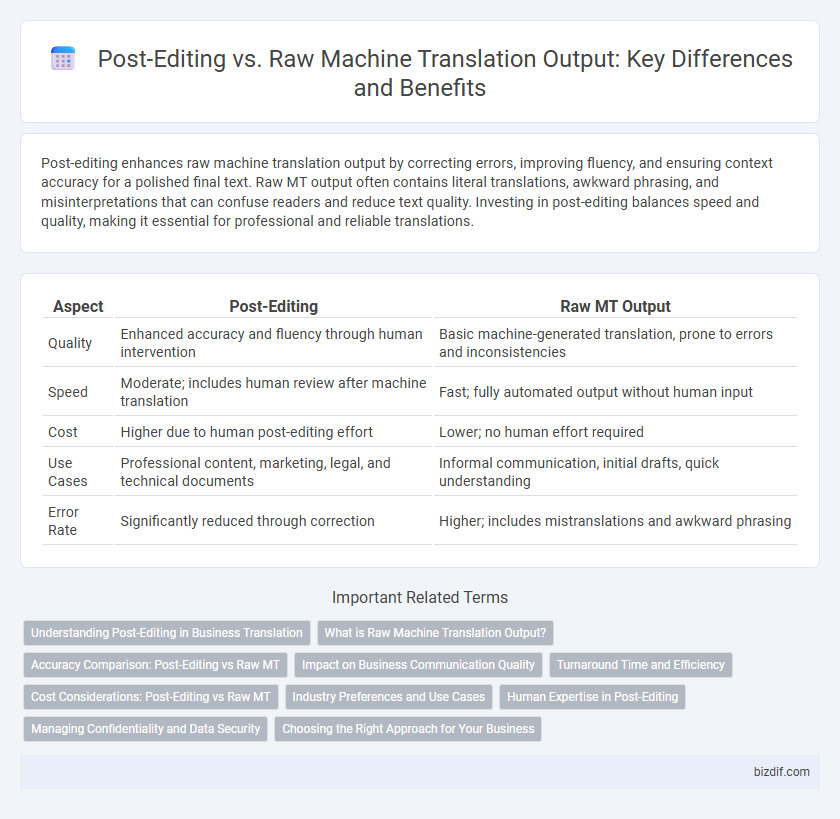Post-editing enhances raw machine translation output by correcting errors, improving fluency, and ensuring context accuracy for a polished final text. Raw MT output often contains literal translations, awkward phrasing, and misinterpretations that can confuse readers and reduce text quality. Investing in post-editing balances speed and quality, making it essential for professional and reliable translations.
Table of Comparison
| Aspect | Post-Editing | Raw MT Output |
|---|---|---|
| Quality | Enhanced accuracy and fluency through human intervention | Basic machine-generated translation, prone to errors and inconsistencies |
| Speed | Moderate; includes human review after machine translation | Fast; fully automated output without human input |
| Cost | Higher due to human post-editing effort | Lower; no human effort required |
| Use Cases | Professional content, marketing, legal, and technical documents | Informal communication, initial drafts, quick understanding |
| Error Rate | Significantly reduced through correction | Higher; includes mistranslations and awkward phrasing |
Understanding Post-Editing in Business Translation
Post-editing in business translation involves refining raw machine translation (MT) output to enhance accuracy, terminology consistency, and cultural relevance, ensuring the final content meets professional standards. Effective post-editing reduces errors that raw MT often produces, such as misinterpretations of technical jargon and idiomatic expressions critical in business contexts. Investing in skilled post-editors improves translation quality, boosts client satisfaction, and supports clear international communication.
What is Raw Machine Translation Output?
Raw Machine Translation (MT) output refers to the unedited, automatic translation generated directly by a machine translation engine without human intervention. It often contains errors such as mistranslations, awkward phrasing, or incorrect terminology that can impact readability and accuracy. Post-editing is required to refine this raw output by correcting mistakes, improving fluency, and ensuring the translation meets quality standards.
Accuracy Comparison: Post-Editing vs Raw MT
Post-editing significantly enhances translation accuracy compared to raw machine translation (MT) output by correcting contextual errors, idiomatic expressions, and grammatical mistakes. Studies indicate post-edited translations achieve accuracy levels exceeding 90%, while raw MT output often falls below 70% accuracy in complex texts. Incorporating human expertise in post-editing ensures semantic fidelity and improves overall translation quality, making it essential for professional localization workflows.
Impact on Business Communication Quality
Post-editing significantly enhances business communication quality by refining raw machine translation (MT) output to ensure accuracy, cultural relevance, and clarity. High-quality post-editing reduces misunderstandings and errors, fostering stronger client relationships and brand reputation. Investing in professional post-editors boosts overall communication efficiency, leading to improved customer satisfaction and market competitiveness.
Turnaround Time and Efficiency
Post-editing machine translation (MT) output significantly reduces turnaround time compared to relying on raw MT output by addressing errors and improving readability swiftly. Efficiency increases as post-editing balances speed with quality, enabling faster delivery of polished translations without extensive manual rewriting. Organizations implementing post-editing workflows report up to 40% faster project completion times while maintaining higher client satisfaction through improved translation accuracy.
Cost Considerations: Post-Editing vs Raw MT
Post-editing machine translation (MT) typically incurs higher costs than using raw MT output due to the additional human effort required to correct errors and enhance fluency. Raw MT output offers immediate, low-cost translation but often sacrifices accuracy and context, which can lead to misunderstanding in critical documents. Choosing between post-editing and raw MT depends on the balance between budget constraints and the need for quality and reliability in translated content.
Industry Preferences and Use Cases
Post-editing of machine translation output is favored in industries requiring high accuracy and context-specific terminology, such as legal, medical, and technical fields. Raw MT output is commonly used for internal communications, quick understanding, or low-stakes content where speed is prioritized over precision. Companies often balance quality and turnaround time by selecting post-editing for client-facing materials while leveraging raw MT for rapid, cost-effective information exchange.
Human Expertise in Post-Editing
Post-editing machine-translated content leverages human expertise to correct inaccuracies, improve fluency, and ensure contextual relevance, resulting in higher-quality translations than raw machine translation output alone. Skilled linguists apply subject-matter knowledge and cultural understanding to address idiomatic expressions and domain-specific terminology that automated systems often misinterpret. This human intervention enhances coherence, preserves intended meaning, and meets the nuanced requirements of professional communication.
Managing Confidentiality and Data Security
Post-editing machine translation (MT) output involves human revision, which requires stringent confidentiality protocols to safeguard sensitive data throughout the process. Raw MT output, generated automatically, poses a higher risk of data exposure without secure handling and encryption measures applied to both the source content and translation platform. Implementing robust data security standards and access controls ensures protection against unauthorized disclosure during both raw MT and post-editing workflows.
Choosing the Right Approach for Your Business
Selecting the optimal translation approach between post-editing machine translation (MT) and raw MT output depends on factors like content complexity, desired quality, and turnaround time. Post-editing enhances accuracy and readability by human translators refining MT output, suitable for high-stakes or customer-facing materials. Raw MT output minimizes costs and speeds delivery but risks lower accuracy, making it ideal for internal use or rapidly evolving content where precision is less critical.
Post-Editing vs Raw MT Output Infographic

 bizdif.com
bizdif.com